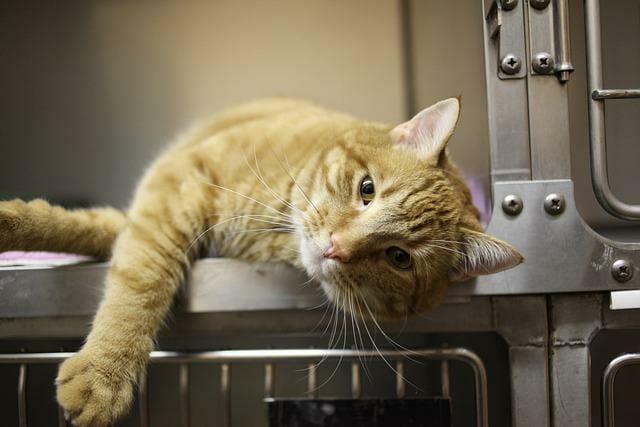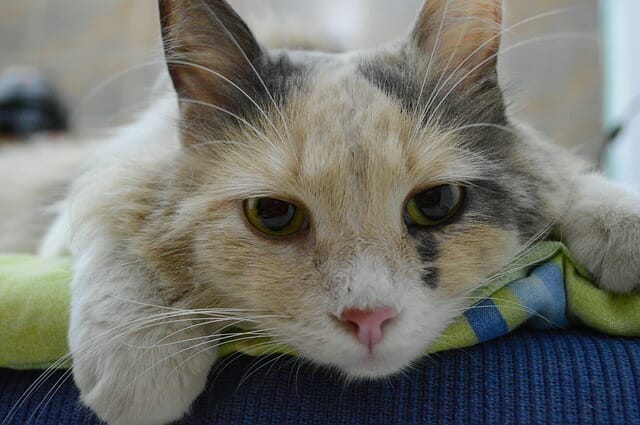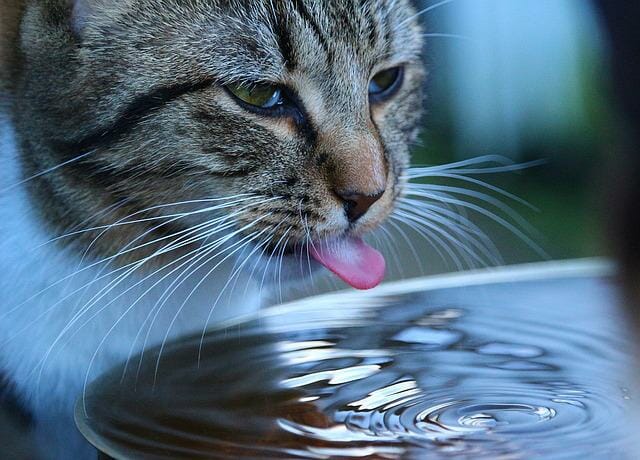How to Know if Cat Has Fever: Signs and Causes of Fever in Cats and How to Deal With It
Some several signs and symptoms may indicate that a cat has a fever, including:


- Increased body temperature: The normal body temperature of a cat ranges between 99.5°F and 102.5°F. If your cat’s temperature rises above this range, it could indicate a fever.
- Lethargy and lack of energy: If your cat is normally active but suddenly becomes lethargic or lacks energy, it may be a sign that they have a fever.
- Loss of appetite: Cats with a fever may refuse to eat or drink.
- Dehydration: A fever can cause cats to lose fluids, so that they may become dehydrated.
- Shivering: If your cat is shivering or trembling, it may be a sign that they are trying to raise its body temperature.
- Sneezing and coughing can be fever symptoms if accompanied by other signs such as lethargy, loss of appetite, and increased body temperature.
Table of Contents
Other Signs of Fever in Cats
Hiding
One of the signs that a cat may have a fever is hiding or being less active than usual. If your cat is usually playful and energetic but suddenly seems to be spending more time hiding, it could be a sign that something is wrong.
If you suspect your cat has a fever, it is important to take its temperature with a thermometer designed for pets. The normal body temperature for a cat is between 100.5°F and 102.5°F (38°C to 39.2°C). If your cat’s temperature is above 102.5°F (39.2°C), it is considered a fever, and you should contact your veterinarian for advice.
Rapid Breathing
Rapid breathing, or panting, is another sign that your cat may have a fever. If your cat is panting or breathing rapidly, monitoring its temperature and contacting your veterinarian for further advice is important. However, it’s important to note that rapid breathing can indicate other health problems, so observing your cat’s behavior and other symptoms is important.
Loss of Grooming Habits


A loss of grooming habits can indicate a cat is not feeling well. However, it is not a specific symptom of fever and can be associated with many other health issues. For example, if a cat is not grooming itself as often as usual, it could be due to pain, discomfort, or lethargy caused by an underlying health problem. However, observing the cat’s behavior and looking for other signs of illness is important to determine whether a fever or veterinary visit is necessary.
Vomiting
Vomiting can also indicate a cat’s fever, although it is not always present. Sometimes, vomiting may be caused by other health issues, such as gastrointestinal problems or hairballs.
However, if your cat is vomiting and displaying other fever symptoms, it is important to contact your veterinarian for further evaluation. In addition, your veterinarian may recommend diagnostic tests to determine the underlying cause of your cat’s fever and vomiting and provide appropriate treatment.
Diarrhea
Diarrhea can also be a symptom of a cat having a fever, although it can also have other causes, such as a change in diet, intestinal parasites, or infections. For example, suppose your cat is experiencing diarrhea and other fever symptoms. In that case, it is best to consult a veterinarian to determine the underlying cause and provide proper treatment.
Causes of Fever in Cats
Bacterial Infections
Bacterial infections can cause fever in cats. These infections are caused by harmful bacteria entering a cat’s body through wounds or cuts, ingesting contaminated food or water, or inhaling bacteria-laden air. In addition, bacteria can enter a cat’s urinary tract through the urethra and cause infection in the bladder or kidneys.


Bacteria such as Bordetella, Chlamydia, and Mycoplasma can cause cat respiratory infections. It can also enter a cat’s skin through wounds or cuts and cause skin infections. Bacteria from the mouth of another animal that has bitten a cat can enter the cat’s body and cause infection. Bacterial pneumonia can cause fever, coughing, and difficulty breathing in cats.
Viral Infections
Viral infections are also a common cause of fever in cats. Some of the common viral infections that can cause a fever in cats to include:
- Feline herpesvirus is a highly contagious virus that can cause respiratory infections and fever in cats. Cats can become infected with the virus through contact with infected cats, contaminated objects, or their mother.
- Feline calicivirus is another highly contagious virus that can cause respiratory infections, fever, and oral ulcers in cats. It can be transmitted through contact with infected cats or contaminated objects.
- According to Cornell University, the feline immunodeficiency virus (FIV) attacks cats’ immune systems, making them more susceptible to infections. Cats can become infected with FIV through bite wounds from infected cats.
- Feline leukemia virus (FeLV): This virus can cause a wide range of cat health problems, including fever, anemia, and cancer. Cats can become infected with FeLV through contact with infected cats, particularly through grooming and sharing food and water bowls.
Parasitic Infestations


Parasitic infestations can cause fever in cats. Parasites live on or inside a host organism and derive nourishment from them. Fleas are the most common external parasites that can affect cats. When fleas feed on a cat’s blood, they inject saliva into the skin, which can cause an allergic reaction and trigger a fever.
Ticks are another type of external parasite that can cause fever in cats. When ticks attach themselves to a cat’s skin and feed on its blood, they can transmit diseases that cause fever, such as Lyme disease, Babesiosis, and Ehrlichiosis.
Internal parasites such as worms and protozoa can cause fever in cats. These parasites can infect the body’s digestive tract or other organs, causing inflammation and triggering a fever.
Fungal Infections
Fungal infections can also cause fever in cats. One of the most common fungal infections in cats is ringworm. This highly contagious infection can spread to other pets and humans in the household. Other fungal infections that can cause cat fever include blastomycosis, histoplasmosis, and cryptococcosis. These infections usually affect the respiratory system and cause other symptoms like coughing and difficulty breathing.
Vaccination Reactions
In rare cases, cats may develop a fever after receiving a vaccination. This is typically a mild reaction and should resolve within a day or two. However, suppose your cat’s fever persists, or they exhibit other symptoms such as vomiting, lethargy, or loss of appetite. In that case, it may be a sign of a more serious reaction, and you should contact your veterinarian.
Heat Stroke
Heat stroke can also be a cause of fever in cats. When a cat’s body temperature rises above the normal range due to exposure to hot and humid conditions or being locked in a hot car, it can cause fever-like symptoms. This is because the body tries to regulate its temperature by increasing blood flow and sweating, which can cause a fever.
If you suspect your cat has heat stroke, it is important to cool them down immediately by moving them to a cooler area and providing fresh water. Heat stroke can be a serious medical emergency, so it is important to seek veterinary care immediately.
Things to Do if Your Cat Has a Fever
Keep Your Cat Hydrated


If your cat has a fever, it is important to keep them hydrated. Make sure they have plenty of fresh water available and consider adding water to their food or offering them wet food instead of dry food to help increase their water intake.
Consider offering your cat a low-sodium chicken or beef broth to encourage them to drink more fluids. Ensure the broth is at room temperature before offering it to your cat.
If your cat is not interested in drinking water or broth, you can offer them ice cubes to lick or suck on. This can help keep them hydrated and cool them down if they are experiencing a fever due to a heat stroke.
Monitoring your cat’s water intake and output is important to ensure they get enough fluids. Contact your veterinarian immediately if your cat drinks or urines less than usual.
Monitor Their Temperature
You can use a digital thermometer for pets to monitor your cat’s temperature. The thermometer can be inserted into the cat’s rectum for an accurate reading. The normal temperature for a cat is between 100.5°F and 102.5°F (38°C to 39.2°C). If your cat’s temperature is above 102.5°F, it is a fever.
It is important to note that taking a cat’s temperature can be challenging, and it may be best to have a veterinarian or a trained professional handle this task to avoid any harm or injury to the cat.
If you suspect that your cat has a fever or any other health issue, it is recommended to seek veterinary care as soon as possible. In addition, a veterinarian will be able to properly diagnose and treat the underlying cause of the fever, which can help to prevent any complications and ensure your cat’s well-being.
Monitor Their Behavior
When your cat has a fever, it is important to monitor their behavior. Look for signs of discomfort or pain, lethargy, lack of appetite, and other unusual behavior. If you notice any concerning changes, it may be a sign that your cat needs immediate medical attention.
Keep your cat comfortable by providing a quiet and cool place to rest. Avoid stressing your cat, and allow them to rest as much as possible. If the fever persists, it is best to seek advice from a veterinarian, as they can determine the underlying cause and prescribe appropriate treatment.
Isolate Your Cat
If you suspect your cat has a fever, it’s a good idea to isolate them from other pets in the home to avoid spreading any possible infections. This can also help reduce stress on your cat and allow them to rest more comfortably. Finally, provide your cat with a quiet, comfortable place to rest and recover.
Follow Your Vet’s Instructions
Following your vet’s instructions is important if your cat has a fever. Your vet may recommend bringing your cat in for an examination to determine the underlying cause of the fever. They may also prescribe antibiotics, anti-inflammatories, or fluids to help treat the fever and any underlying condition.
Following their instructions for administering medications and monitoring your cat’s condition is important. Additionally, you may need to adjust your cat’s diet or provide supportive care such as keeping them comfortable, providing extra rest, and ensuring they have a quiet, stress-free environment to recover.
